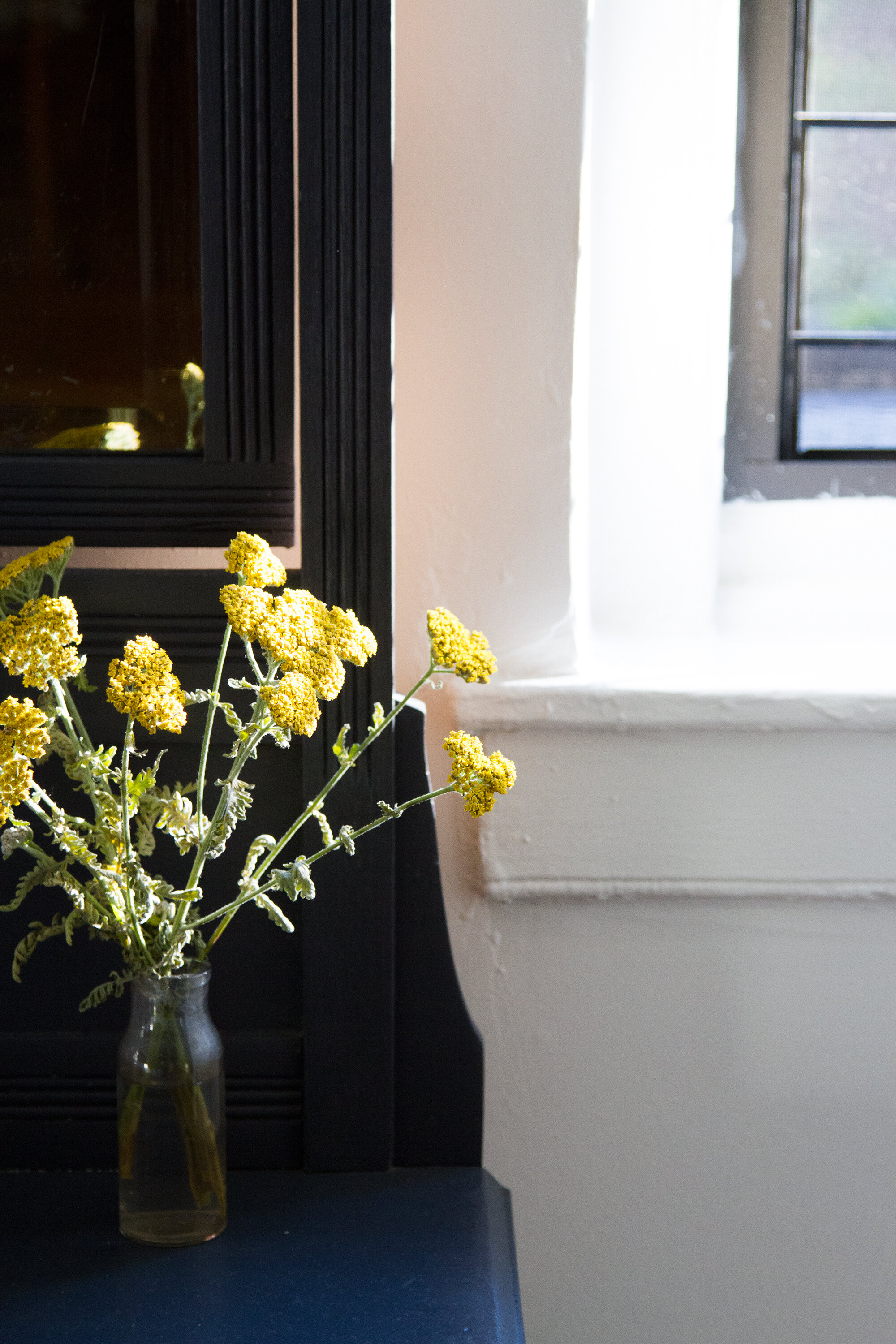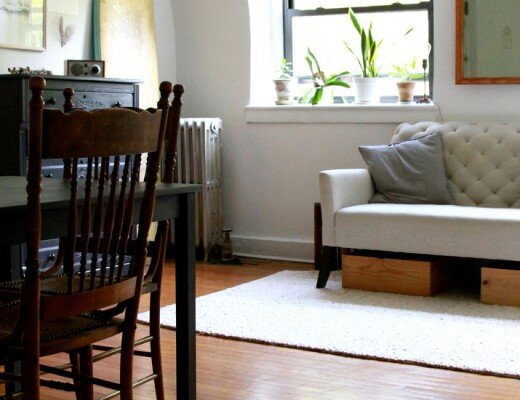 On my first morning of the fifth grade, I got dressed for school from the comfort of a campground. My three sisters and I, along with our mom, had spent the summer living with my grandparents in another town while most days my dad donned a hazmat suit and worked steadily to remove lead paint from our ancient house. By the time the new school year rolled around, the job still wasn’t quite finished and it would be a couple of weeks before we could move back home.
On my first morning of the fifth grade, I got dressed for school from the comfort of a campground. My three sisters and I, along with our mom, had spent the summer living with my grandparents in another town while most days my dad donned a hazmat suit and worked steadily to remove lead paint from our ancient house. By the time the new school year rolled around, the job still wasn’t quite finished and it would be a couple of weeks before we could move back home.
My parents bought the house that I grew up in when I was six and the house was two-hundred and fifty-one. It was the early 1990s and if you ask my mom, she’ll tell you that my parents’ signing on the dotted line coincided nearly exactly with publication of the first in a series of major news stories aimed to raise public awareness about the hazards of lead paint. My parents were only the latest in a line of stewards of this New England farmhouse, chock full of the hazard. It was too late to back out of the purchase. A few years later and many admonishments to not touch the woodwork later, my dad tackled the project himself.
Without wanting to be an alarmist, the dangers of lead contamination in paint and soil and drinking water are pretty significant, especially for families with little kids. Lead exposure can lead to developmental and behavioral issues and delay both physical and mental development.
Since our own recent temporary move was caused by needing to have lead paint risks mitigated in our current apartment, I thought it might be helpful to put together a very brief primer on some of the main things to watch out for along with a list of resources for learning more.
A few basic things to know:
+ Lead was used in oil-based paints until it was banned for residential use in 1978. If you live in any home built prior to 1978, unless it’s been properly remediated, it’s safe to assume there is lead lurking in the paint.
+ The danger from lead mostly comes when lead-based paint is disturbed. Some of the ways that disturbance can happen are obvious: ripping out woodwork, sanding old furniture or trim, or knocking a hole in the ceiling or walls. Other ways you can become exposed to lead paint are somewhat more subtle: a painted door that sticks and creates paint dust each time it’s opened or closed; painted windows and accompanying accumulation of paint chips in their sills, painted drawers or cabinets that create dust from the friction of being opened and closed, and general wear and tear.
+ If you’re a tenant, you have the right to be protected from lead paint. It’s worth looking up your local laws on this front, but in New York City, for instance, the Childhood Lead Poisoning Prevention Act requires landlords to identify and remediate lead-based paint hazards in apartments of young children, using trained workers and safe work practices. When I became concerned about chipping paint in our apartment earlier this year, I filled out the form we’ve received at the beginning of every year, indicating that we had children under the age of six living in our apartment. (This is something I could have—and surely should have—done as soon as Faye was born.) As a result of filling out the form, our landlords were required to have the apartment tested for lead by an accredited firm. When those tests came back positive, they were required to hire another firm to fix the problem and to retest for lead dust once the work was done.
+ When a lead test comes back positive, there are a number of routes you can take to reduce the risks of exposure. These range from a full lead-paint removal, like my dad did in my childhood home, to encapsulation, which is essentially covering lead paint with a special primer to prevent exposure. Encapsulation is the cheapest method. It’s very effective but it’s important to remember that disturbing areas where encapsulation has been put in place will mean lead exposure. This is why it’s important not to take on demolition work while young kids are living in an apartment. (For clarification, this is also why we decided to take advantage of replacing our bathroom mirror while we were living downstairs and while lead work was underway upstairs. That way, we knew that any possible lead paint that was disturbed in the process would also by properly cleaned up.)
+ How to know if you have lead? You can buy home lead test kits and test yourself or You can hire a company to use a special machine to test your woodwork for lead or send a chip in for lab testing yourself. UPDATE: A quick note to clarify that we had our home professionally tested for lead. Whether someone comes to your home to test or you send a paint chip into the lab for testing, the safest route to go is with professional lab tests.
+ If you and your landlord is contracting out the work, make sure that you’re working with lead-safe certified contractors. These folks are required to renew their certifications and practice safe removal, remediation, and retesting to make sure everything’s been properly cleaned up.
Beyond lead paint:
+ Lead contamination of water has been distressingly in the news because of the widespread contamination in Flint, Michigan, but it’s wise not to think of this as a problem only in someone else’s backyard. Get your water tested for lead. If you live in New York City, you can hire a lead test kit for free. When we first moved into this building we wrote away for the test, filled up the provided bottles with tap water and sent them back off to the lab to be tested. It’s a simple step to take to feel better (or discover you’ve got a problem that needs fixing).
+ Lead contamination of soil is another pretty significant concern, especially for parents of small kids who might especially enjoy digging in the dirt. If you have young children or you’re hoping to plant a vegetable garden, it’s a good idea to get your soil tested for lead contamination (especially in garden beds that might be directly next to a house.) Here are a few soil testing resources to look into.
+ While less common than lead paint, if you’re embarking on any kind of renovation project or living in an older home, asbestos is another dangerous material that you might want to keep an eye out for, especially if you’re dealing with old floor tiles or insulation. Here’s some more information on that this way.
+ I’m not a lead authority, but there are plenty of people who are. Here are a few good resources for learning more and making decisions about how to stay safe.
Prevent Children’s Exposure to Lead – Center for Disease Control
Lead-Based Paints Maintenance Requirements – New York City Housing Preservation & Development
Reducing Childhood Lead Exposure – Environmental Protection Agency




17 Comments
When my son was a baby we lived in an old apartment and at one year he was found to have elevated lead levels. We were about to move, but I was still freaked out. The people I spoke to at the national lead hotline were really helpful, if you need those resources definitely give them a call!
So glad to hear that! Adding a direct link above.
Good you are raising awareness to this. I had a personal story to tell around this subject but it’s too sad so just let me leave my words here: lead dangers are real.
We live in San Francisco and when our daughter turned one her doctor recommended a lead test for her blood. Thankfully it came back negative. I wonder if this is standard practice for children everywhere or if it is only common in areas like ours with mostly older buildings. I also wonder about the lead content of all those cheap plastic toys kiddos play with and chew on.
Yes: requirements for testing changes state to state. In New York State all children are required to be tested at age 1 and again at 2. There’s more info on NYS here: https://www.health.ny.gov/publications/2526.pdf
I became extra concerned about lead in our 98-year-old house when I was pregnant, and started looking into abatement–only to find that it would be about a $10,000 enterprise for our 1200 square foot home. I thought surely there would be government programs to help with the cost, but no dice. Our little guy is 17 months now and his lead levels are thankfully low, but the risk is there, for him and for so many other children living in older homes. If we absolutely had to, we could manage the cost. That’s not the case for most families. I’d love to see widespread relief programs for lead abatement as a public health initiative.
A few other words from a paint scientist: Lead-based oil paints are really sturdy, they still haven’t managed to make a modern paint that matches them in durability…which is unfortunately while you’ll often find lead paint hanging around underneath more recent paint layers. It is the stable paint layer that you will scrape down to if you are repainting an area. But it was also more expensive, so in many houses it will be used primarily on trim, exterior etc. So if you are thinking of testing yourself, I’d focus first on the trim. We have found that there can also be cheap places to order lots of lead test kits in bulk. If you are going to do any stripping on your own, definitely work wet with chemical paint strippers, not sanding, otherwise the dust gets everywhere and you have a cleanup nightmare (ask my husband…also, why we needed to buy test kits in bulk!)
For those worried about lead in water, a regular water filter (Britta pitcher, etc) does a really good job of getting out the lead.
In regards to the asbestos danger….. a year ago my son bought a house and moved his family in. Over the next couple of weeks they became concerned about discovering small chunks of acoustic ceiling ( popcorn ) on elevated horizontal surfaces as well as floor vents. The heater was not working properly and the service person discovered the unit had white powder all over the coils. We immediately had the substances tested and discovered it to indeed be asbestos laden acoustic ceiling material in a friable state. They left the house and all of their belongings and spent the following year living first with me, then with my daughter’s family while dealing with the situation. Further specialist and testing revealed the likely contamination of all furniture, clothes, electronics, appliances due to the product being airborne. The cost for proper abatement and cleaning of belongings at this point was huge. Long story short, the house sale was rescinded but not without great financial loss. The family was not going to be compensated for loss of property without a long legal battle. The law about asbestos in California does not allow you to remove the product for selling property without using proper abatement measures. The seller DIY removed the product earlier in the year while getting ready to sell. Apparently you can claim ignorance to this. There is more to this story and too much to write in comments. Be aware of this issue when buying or selling an older house with this ceiling. It was used for ceilings a great deal in the 1970s, as well as other building material for several decades. Ask questions and ask for testing. You never know what the seller did to ready the house for sale and if they did it not knowing of the dangers. The good news is that the family has settled into a new house, built in the last decade , and are slowly furnishing etc. The trauma of the whole ordeal will slowly heal.
Thanks for this! Lots of good resources. I moved into my Harrisburg PA house last summer and have been trying to decide whether or not to check for less before we plant a garden. This has inspired me to do it!
Also side note, when looking at houses last year, we were in the basement of one and my uncle casually pointed out some asbestos. While impressed by his non-chalance, I was like “Let’s get out of here!”
Thank you so much for writing this! Lead paint has always felt like the “boogeyman” to me somehow – always lurking as a threat, never fully understood. It feels like such an overwhelming topic.
Something else worth mentioning, particularly for those of us who tend towards the nostalgic (ahem) is that old toys can also be a source of lead exposure. I had a huge collection of My Little Ponies that I saved with dreams of passing on to my kids someday, but after reading things like this article: https://www.independent.co.uk/news/uk/home-news/toys-from-the-seventies-and-eighties-could-be-poisoning-your-children-10125415.html which cites that 25% of toys, often the plastic toys from the 70s and 80s that made up my childhood toy bins, were found to have more than 10 times the current safety limits for lead – well, I have not chucked the ponies just yet but I have held off on them until I get a home lead-test kit, at least. :/
Another argument in favor of simple toys made from natural materials! But, sigh, my Ponies.
A suggestion: photograph them if you have to toss them. This way you’ll have cute, artistic photos and the memories. I did this with my Grandmother’s collection of small items; shells, miniature dolls, horses, turtles etc ; which will probably eventually get divided up.
Thank you for this; we had a smelter that was operational in our town for decades before being shut down(and now, gone completely). The entire town is contaminated by lead- something they’ve been working hard since I was a child to get fixed. Thankfully, with any luck, the last of it’s been completed. But it was a long and arduous journey, and many of the people here will have health problems for the rest of their lives because of it.
I can’t stress how important lead testing and remediation is- and asbestos testing and remediation, too- as someone who grew up in a town contaminated to its very core.
I just called our pediatrician and lead testing is standard in Colorado at 9 months and consists of a finger poke. My kids are 4 and 5 and we live in an older home, so I’m glad that they are testing for it even if I wasn’t aware of it at the time! Thanks for putting this on my radar!
Good on you for getting ahead of this problem! I agree, there needs to be more support for lead safety measures. Thanks for sharing.
My husband and I have had a many experiences with lead-based paint etc. (always rented or owned old homes and condos) and have had high lead levels myself. A few tips:
We’ve used Lead Defender (a paint product used to encapsulate lead-based paint), and replaced windows that have lead paint (it’s good to note that most window companies are required by law (at least in IL) to test for lead paint before doing any demolition work – if positive, they have to follow strict protocol when installing the windows).
Water: I would encourage folks to send water samples to a private testing lab vs. the city. We lived on the south side of Chicago, had our water tested by the city and it came back negative. About a year later, an investigative report revealed high levels of lead in our neighborhood’s water. SO! We use a Berkey water filter (can’t recommend enough) for drinking water. We also installed a whole-house purifier (make sure that it specifically filters out lead). Berkey also sells a shower filter via Amazon. Also, it’s not a bad idea to check your pipes (again, older home) to make sure they’ve all been converted to copper, galvanized steal or PVC. You can check by using a magnet – if it sticks, it’s steal and not lead (google for more accurate details).
Embarrassing how long this comment is – so glad you’re talking about how important our environments are to our health, Erin – thank you!
https://www.berkeyfilters.com/
I’ve been following your experiences here and on Instagram and I’m glad that you are finally at the end of it!
I just found an article about how leaded gasoline from the 40s-70s was already really terrible and how it’s actually still affecting us today: https://www.motherjones.com/environment/2016/02/lead-exposure-gasoline-crime-increase-children-health/
And figured I would share it since it’s sort of relevant!!
Glad you are talking about this! Another important note… asbestos was also banned in 1978 but suppliers/contractors were allowed to continue using their supply of it (they just weren’t allowed to purchase more). So residences built after 1978 can also be affected. I believe but am not positive that the same goes for lead – they could still use what they had after 1978. Just ask me how I know. 🙁
Comments are moderated.